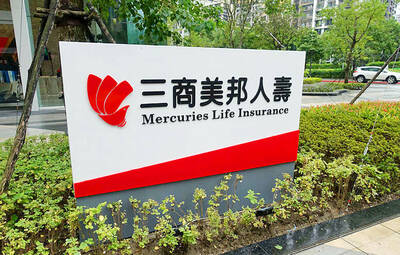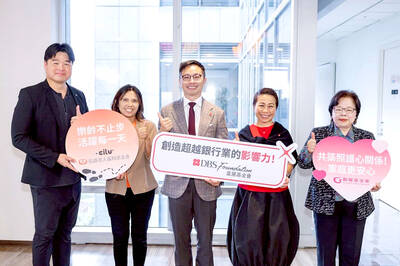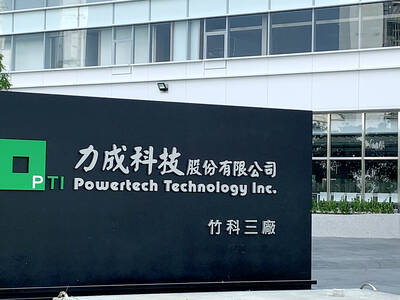E Ink Holdings Inc (元太科技), the world’s sole e-paper display supplier, yesterday said it expects to continue to grow its business next year as large-scale retailers in the US are joining their European counterparts to install electronic shelf labels (ESLs) as a labor shortage drags on.
Walmart Inc earlier this year announced a plan to adopt ESLs after nearly eight years of evaluations, while Best Buy Co and Home Depot Inc also adopted the cost-efficient electronic labels, following in the footsteps of Carrefour SA and Tesco PLC in Europe.
“We believe E Ink will grow next year, despite the global economy facing rising recession risks... The [revenue] growth might not be as dramatic as this year’s,” E Ink chairman Johnson Lee (李政昊) told a media gathering in Taipei yesterday.

Photo courtesy of E Ink Holdings Inc
If the global economy enters a recession next year, retailers might hesitate about spending on ESLs, the company said.
E Ink’s revenue soared 67 percent year-on-year in the first three quarters of this year to NT$21.52 billion (US$701.3 million), the company’s highest revenue for the period.
More than half of the company’s revenue came from the ESL segment, the first time the business became the firm’s major source of income, E Ink said.
The company’s ESL business is expected to post its fastest growth next year, as large-scale retailers, including Best Buy and Amazon.com Inc are to install the devices, E Ink said.
“We are seeing that more retailers are willing to introduce ESLs extensively,” Lee said. “This year, we are benefiting from wide adoption of ESLs from some European retailers. We have been endeavoring to ship goods there.”
About 600 million ESLs were installed from 2012 to last year, accounting for about 10 percent of the overall market of 6 billion shelf labels, Lee said.
As long as the penetration rate continues to rise, there would be growth opportunities for the company, he said.
There is also replacement demand, Lee said, adding that the lifecycle of an electronic label is seven to eight years.
E-paper displays used in e-notes would be the company’s second growth engine next year, as the world’s top 10 tablet vendors, except Apple Inc and Samsung Electronics Co, have rolled out e-notes, Lee said.
E Ink president F.Y. Gan (甘豐源) said electronic labels used on packing boxes would be the next market with strong growth potential.
Each year, about 10 billion boxes are consumed worldwide, which is a huge number, Lee said.
Like ESLs, Europe would be the first adopter of electronic labels for packing boxes, as the EU stipulates that all such containers must be made reusable by 2030, he said.
Electronic labels can be used to track the usage of such boxes, he added.

Mercuries Life Insurance Co (三商美邦人壽) shares surged to a seven-month high this week after local media reported that E.Sun Financial Holding Co (玉山金控) had outbid CTBC Financial Holding Co (中信金控) in the financially strained insurer’s ongoing sale process. Shares of the mid-sized life insurer climbed 5.8 percent this week to NT$6.72, extending a nearly 18 percent rally over the past month, as investors bet on the likelihood of an impending takeover. The final round of bidding closed on Thursday, marking a critical step in the 32-year-old insurer’s search for a buyer after years of struggling to meet capital adequacy requirements. Local media reports

US sports leagues rushed to get in on the multi-billion US dollar bonanza of legalized betting, but the arrest of an National Basketball Association (NBA) coach and player in two sprawling US federal investigations show the potential cost of partnering with the gambling industry. Portland Trail Blazers coach Chauncey Billups, a former Detroit Pistons star and an NBA Hall of Famer, was arrested for his alleged role in rigged illegal poker games that prosecutors say were tied to Mafia crime families. Miami Heat guard Terry Rozier was charged with manipulating his play for the benefit of bettors and former NBA player and

The DBS Foundation yesterday announced the launch of two flagship programs, “Silver Motion” and “Happier Caregiver, Healthier Seniors,” in partnership with CCILU Ltd, Hondao Senior Citizens’ Welfare Foundation and the Garden of Hope Foundation to help Taiwan face the challenges of a rapidly aging population. The foundation said it would invest S$4.91 million (US$3.8 million) over three years to foster inclusion and resilience in an aging society. “Aging may bring challenges, but it also brings opportunities. With many Asian markets rapidly becoming super-aged, the DBS Foundation is working with a regional ecosystem of like-minded partners across the private, public and people sectors

BREAKTHROUGH TECH: Powertech expects its fan-out PLP system to become mainstream, saying it can offer three-times greater production throughput Chip packaging service provider Powertech Technology Inc (力成科技) plans to more than double its capital expenditures next year to more than NT$40 billion (US$1.31 billion) as demand for its new panel-level packaging (PLP) technology, primarily used in chips for artificial intelligence (AI) applications, has greatly exceeded what it can supply. A significant portion of the budget, about US$1 billion, would be earmarked for fan-out PLP technology, Powertech told investors yesterday. Its heavy investment in fan-out PLP technology over the past 10 years is expected to bear fruit in 2027 after the technology enters volume production, it said, adding that the tech would